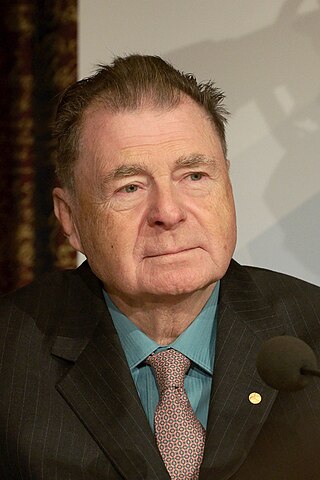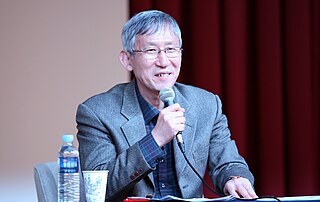The Ullmann reaction or Ullmann coupling, named after Fritz Ullmann, couples two aryl or alkyl groups with the help of copper. The reaction was first reported by Ullmann and his student Bielecki in 1901. It has been later shown that palladium and nickel can also be effectively used.
The Negishi coupling is a widely employed transition metal catalyzed cross-coupling reaction. The reaction couples organic halides or triflates with organozinc compounds, forming carbon-carbon bonds (C-C) in the process. A palladium (0) species is generally utilized as the catalyst, though nickel is sometimes used. A variety of nickel catalysts in either Ni0 or NiII oxidation state can be employed in Negishi cross couplings such as Ni(PPh3)4, Ni(acac)2, Ni(COD)2 etc.

Richard Frederick Heck was an American chemist noted for the discovery and development of the Heck reaction, which uses palladium to catalyze organic chemical reactions that couple aryl halides with alkenes. The analgesic naproxen is an example of a compound that is prepared industrially using the Heck reaction.
Melanie Sarah Sanford is an American chemist, currently the Moses Gomberg Distinguished University Professor of Chemistry and Arthur F. Thurnau Professor of Chemistry at the University of Michigan. She is a Fellow for the American Association for the Advancement of Science, and was elected a member of the National Academy of Sciences and the American Academy of Arts and Sciences in 2016. She has served as an executive editor of the Journal of the American Chemical Society since 2021, having been an associate editor of the since 2014.

Scott Eric Denmark is an American chemist who is the Reynold C. Fuson Professor of Chemistry at the University of Illinois at Urbana-Champaign (UIUC). Denmark received an S.B. degree from MIT in 1975 and the D.Sc.Tech. degree from ETH Zurich in 1980, under the supervision of Professor Albert Eschenmoser. He joined the faculty at UIUC the same year and became an associate professor in 1986, full professor in 1987, and was named the Fuson Professor of Chemistry in 1991. He served as the president and editor-in-chief of the Organic Reactions book series between 2008 and 2018. In 2017, Denmark was elected to the American Academy of Arts and Sciences. In 2018, he was elected to the National Academy of Sciences.
Donna Blackmond is an American chemical engineer and the John C. Martin Endowed Chair in Chemistry at Scripps Research in La Jolla, California. Her research focuses on prebiotic chemistry, the origin of biological homochirality, and kinetics and mechanisms of asymmetric catalytic reactions. She is known for her development of Reaction Progress Kinetic Analysis (RPKA), analysis of non-linear effects of catalyst enantiopurity, biological homochirality, and amino acid behavior.
In organic chemistry, the Fujiwara–Moritani reaction is a type of cross coupling reaction where an aromatic C-H bond is directly coupled to an olefinic C-H bond, generating a new C-C bond. This reaction is performed in the presence of a transition metal, typically palladium. The reaction was discovered by Yuzo Fujiwara and Ichiro Moritani in 1967. An external oxidant is required to this reaction to be run catalytically. Thus, this reaction can be classified as a C-H activation reaction, an oxidative Heck reaction, and a C-H olefination. Surprisingly, the Fujiwara–Moritani reaction was discovered before the Heck reaction.
Abigail Gutmann Doyle is a professor of chemistry at the University of California, Los Angeles, where she holds the Saul Winstein Chair in Organic Chemistry. Her research focuses on the development of new chemical transformations in organic chemistry.
Clark Landis is an American chemist, whose research focuses on organic and inorganic chemistry. He is currently a Professor of Chemistry at the University of Wisconsin–Madison. He was awarded the ACS Award in Organometallic Chemistry in 2010, and is a fellow of the American Chemical Society and the American Association for the Advancement of Science.

Paul James Chirik is an American chemist known for his work in sustainable chemistry using Earth-abundant metals like iron, cobalt, and nickel to surpass the performance of more exotic elements traditionally used in catalysis. He is the Edwards S. Sanford Professor of Chemistry and chair of the chemistry department at Princeton University.
Sarah Elizabeth Reisman is the Bren Professor of Chemistry and the Chair of Division of Chemistry and Chemical Engineering at California Institute of Technology. She received the (2013) Arthur C. Cope Scholar Award and the (2014) Tetrahedron Young Investigator Award for Organic Synthesis. Her research focuses on the total synthesis of complex natural products and data-driven developments of asymmetric catalysis.

Vy Maria Dong is a Vietnamese-American Chancellor's Professor of Chemistry at the University of California, Irvine (UCI). Dong works on enantioselective catalysis and natural product synthesis. She received the Royal Society of Chemistry's Merck, Sharp & Dohme Award in 2020, the American Chemical Society's Elias James Corey Award in 2019, and the UCI's Distinguished Alumni Award in 2018.

Sukbok Chang is a South Korean organic chemist. He is a distinguished professor in the Department of Chemistry at Korea Advanced Institute of Science and Technology (KAIST). He is also the director of the Institute for Basic Science (IBS) Center for Catalytic Hydrocarbon Functionalizations (CCHF). He was an associate editor on ACS Catalysis and has served on the editorial advisory boards of The Journal of Organic Chemistry, Journal of the American Chemical Society, and Accounts of Chemical Research. His major research interest is transition metal catalyzed C-H bond functionalization for the carbon-carbon bond and carbon-heteroatom bond formation.

Dhevalapally B. RamacharyFTAS, FRSC, FASc, FNASc, also known as D. B. Ramachary, is an Indian chemist and professor at the School of Chemistry, University of Hyderabad. He has made numerous contributions in various fields of chemical science.
Thomas Lectka is an American organic chemist, academic and researcher. He is Jean and Norman Scowe Professor of Chemistry and leads the Lectka Group at Johns Hopkins University.
T.V. (Babu) RajanBabu is an organic chemist who holds the position of Distinguished Professor of Chemistry in the College of Arts and Sciences at the Ohio State University. His laboratory traditionally focuses on developing transition metal-catalyzed reactions. RajanBabu is known for helping develop the Nugent-RajanBabu reagent, a chemical reagent used in synthetic organic chemistry as a single electron reductant.
Ohyun Kwon is an American chemist who is a professor at the University of California, Los Angeles. Her research considers new methodologies for organic transformations and the development of chiral catalysts.
Kay Michille Brummond is an American synthetic chemist who is Professor of Chemistry and Associate Dean of Faculty at the University of Pittsburgh. Her interests consider cycloaddition reactions that can realise molecules and natural products for organic photovoltaics and targeted covalent inhibitors. She was elected a Fellow of the American Chemical Society (ACS) in 2010, a Fellow of the AAAS in 2021, and awarded the ACS National Award for Encouraging Women into Careers in the Chemical Sciences in 2021.
Jennifer Schomaker is an American chemist who is a professor at the University of Wisconsin–Madison. Her research considers the total synthesis of natural and unnatural products. She was selected as an American Chemical Society Arthur C. Cope Scholar Awardee in 2021.
Oxidative coupling of phenols is a chemical reaction wherein two phenolic compounds are coupled via an oxidative process. Oxidative phenol couplings are often catalyzed by transition metal complexes including V, Cr, Mn, Cu, Fe, among others. Such reactions often form C–C, or C–O bonds between the coupling partners and can be employed as either homo- or cross-couplings.






